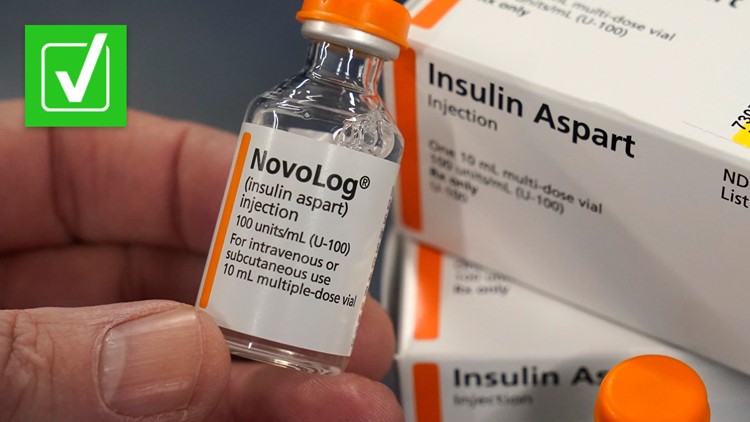UPDATE: On Aug. 16, President Joe Biden signed the Inflation Reduction Act into law. The original story continues as written below:
The Senate recently passed the Inflation Reduction Act after a marathon session debating elements of the budget bill that tackles climate change, taxes and drug prices. One of those elements was a $35 monthly price cap for insulin, which the bill originally set for people on both government healthcare programs and private insurance.
Senate rules dictated that the cap for private insurers had to be approved by 60 Senators — the bill as a whole just needed 50 votes to pass — but only 57 Senators, all Democrats and seven Republicans, voted for it. That meant the final text of the bill did not include the insulin price for private insurance, but did include the price cap for Medicare patients.
Two viral tweets sent on the day the Senate bill passed compared the average price of insulin in the U.S. to the average price in Japan, Canada, France, the United Kingdom, Germany and Australia. Both tweets claim the price of insulin in the U.S. is $98.70, while the next highest insulin price on the list is $14.40 per unit in Japan.
Insulin is a hormone that helps the body use or store the glucose, or blood sugar, it gets from food. In people with type 1 diabetes, the kind that isn’t caused by diet or lifestyle habits, the body stops producing its own natural insulin and requires insulin shots to regulate glucose in the bloodstream and produce energy from it. People with type 2 diabetes still make insulin, but their bodies don’t respond well to it. They sometimes need insulin shots so their bodies can use glucose for energy.
THE QUESTION
Are U.S. insulin prices several times higher than Japan, Canada, France, the United Kingdom, Germany and Australia, like viral tweets claim?
THE SOURCES
- U.S. Department of Health and Human Services (HHS)
- RAND Corporation, a research organization that studied international insulin prices for the HHS
- 3 Axis Advisors report comparing insulin prices in 20 countries
- GoodRx, an online service for comparing prescription prices
- Health System Tracker, a monitor of U.S. healthcare quality and cost run in partnership between health nonprofits Peterson Center on Healthcare and the Kaiser Family Foundation
THE ANSWER
Yes, U.S. insulin prices are several times higher than they are in these six other countries.
WHAT WE FOUND
The two tweets that compare the price of insulin in the U.S. to the price of insulin in Japan, Canada, France, the United Kingdom, Germany and Australia are both referring to a report the research organization RAND Corporation produced comparing U.S. insulin prices to the prices in other countries. The RAND Corporation created the report for the U.S. Department of Health and Human Services.
In September 2018, the RAND Corporation compared insulin prices between 33 countries in the Organisation for Economic Cooperation and Development (OECD). The OECD is a collection of high-income countries that includes the United States. RAND found the average gross manufacturer price for the average single vial of insulin was $98.70 in the U.S., more than 10 times the average price of the same amount of insulin in the study's other 32 countries combined.
Insulin prices for the six countries in the viral tweets were exactly as the tweets said. Insulin prices in Japan, which were the highest of the six, were $14.40. Insulin prices in Australia, the lowest of the six, were $6.94.
RAND found the average U.S. price of insulin was more than four times higher that of any other country in the OECD. Chile’s insulin prices, the next most expensive country, were $21.48 per unit. The lowest average cost of insulin was in Poland, where it was $5.28 per unit.
The RAND Corporation said it used the list prices set by drug manufacturers because they were the most available for comparison across different countries. Drug pricing in the U.S. is a complicated, closed-door process, the organization explained, in which drug manufacturers set list prices high then compete with each other for insurance companies’ business by offering generous discounts to the insurance companies.
This system makes it hard to track the final prices patients actually pay at the pharmacy counter, RAND explained. Even after this discount process, people with insurance might still have to cover significant deductibles and copays, and people who don't have insurance can end up paying for the full list price.
Data from GoodRx, an online service for comparing prescription prices, also confirms RAND’s findings for the average price of insulin in the U.S., finding that a 3 mL pen or vial averaged about $99 in 2018. The average price has dropped slightly since then, and is now about $93, according to GoodRx’s data.
Other sources have also noted a significant discrepancy between U.S. insulin prices and the prices in other countries.
A November 2021 report by 3 Axis Advisors, a research company that focuses on the prescription drug supply chain, confirmed Rand’s findings that the price of insulin in the U.S. far exceeds the prices in other countries. Of the 20 countries 3 Axis Advisors compared, which included three OECD countries included in the RAND Corporation’s report, several middle-income countries and several low-income countries, the average price of insulin in the U.S. far exceeded the rest, even when broken down by different types of insulin medication.
Andrew Mulcahy, one of the authors of the RAND report, told VERIFY in an email that insulin price ratios between the U.S. and other countries are similar regardless of how they're calculated. He specifically named measures by vials or cartridges, like how RAND measured prices, and measures by insulin units, like how GoodRx measures prices.
According to the Health System Tracker, a partnership between health nonprofits Peterson Center on Healthcare and the Kaiser Family Foundation (KFF), about 1 in 4 enrollees in individual or small group insurances who take insulin paid more than $35 a month, the proposed price cap that failed to make the final bill. About 1 in 5 insulin users with large employer insurance coverage paid more than $35 a month.
The Health System Tracker found people with plans in which the insurer pays high shares of a prescription drug’s cost rarely pay more than $35 a month on insulin, indicating that the affordability of insulin in the U.S. is highly dependent on a person’s health insurance plan, if they have one at all.
More from VERIFY: No, Congress is not considering $300 billion Medicare cut



